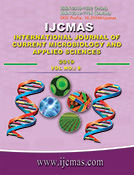


 National Academy of Agricultural Sciences (NAAS)
National Academy of Agricultural Sciences (NAAS)

|
PRINT ISSN : 2319-7692
Online ISSN : 2319-7706 Issues : 12 per year Publisher : Excellent Publishers Email : editorijcmas@gmail.com / submit@ijcmas.com Editor-in-chief: Dr.M.Prakash Index Copernicus ICV 2018: 95.39 NAAS RATING 2020: 5.38 |
Nitrogenous fertilizers applied to soil undergo various physico-chemical and biological transformations due to influence of different enzymes and microbial activity and thereby become available to crops. The efficient use of nitrogen is recognized as an important production factor for rice production but it has always been a problem to raise its utilization rate by rice and to increase efficiency of absorbed nitrogen for grain production. Even with the best agronomic practices only 30-40 percent of applied nitrogen is actually utilized by the crop. A field experiment was conducted in kharif 2017 at the Research cum Instructional Farm, Indira Gandhi Krishi Vishwavidyalaya, Raipur (C.G). Rice variety Rajeshwari was taken as test crop under irrigated condition. The experiment was laid out in randomized complete block design comprising of total 11 treatments; out of which, four treatments involving application of urea briquettes, another four treatments involving application of urea and rest three treatments involving application of briquettes of urea + FYM, urea + vermicompost and urea + neem cake as source of nitrogen along with varying doses of phosphorus and potassium. Each treatment was replicated four times. The influence of the different levels and sources of Non root growth and nitrogen losses was studied under different treatments. The results revealed that Nitrogen losses in irrigated rice were significantly influenced by the treatments. The concentration of nitrates and ammonia found in leachates in treatments involving urea+organics briquettes were found significantly lower compared to rest treatments. There was a progressive increase in root dry weight and volume with the advancement of crop growth stage. The effect of different nitrogen levels and sources was found statistically significant on root growth. The highest value of root volume and dry weight were found in in treatments involving urea+FYM briquettes application. The addition of organics in urea briquettes and deep placement of briquettes exhibited better root development and lower nitrogen losses which might be attributed to slow release of nitrogen and thus reducing the losses and thereby higher nutrients uptake and ultimately higher root biomass.
 |
 |
 |
 |
 |